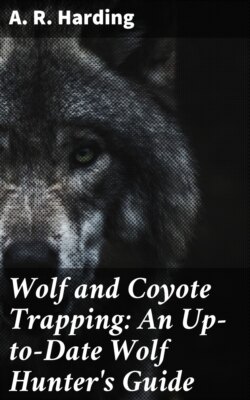Читать книгу Wolf and Coyote Trapping: An Up-to-Date Wolf Hunter's Guide - A. R. Harding - Страница 10
На сайте Литреса книга снята с продажи.
CHAPTER II.
THE COYOTE.
ОглавлениеTable of Contents
In the western parts of the United States, the coyote is far more abundant than the grey, or timber wolf, but its range is more limited as it is found only in those parts lying west of the Mississippi River and in the western portion of the Dominion of Canada. As there are a number of varieties of the timber wolf, so it is with the coyote, but naturalists have never yet been able to agree on the number of types and their distribution. In the Southwest, it appears there are several distinct varieties, showing considerable difference in size and color. Mr. Vasma Brown, a noted coyote trapper of Texas has the following to say on the subject:
"I have lived in Texas nineteen years and have had some years of experience with the coyotes, coons and cats. Some coyotes are of a silver-grey color, others are dark brown. The ends of their hair are jet black and it makes them look brown. Some have black tips on the tail and some white. The dark variety are the most vicious of the two."
With the exception of the southwestern section, it is probable that the coyotes of all portions of the Great Plains and the country to the westward are of the same variety, and a description of this, the most common type will answer for the species. In size, the coyote or prairie wolf is considerably smaller than the timber wolf, the largest specimens of the former being about equal in size to the smallest adult wolves. The average coyote will measure about thirty-six or thirty-eight inches from the end of the nose to the base of the tail, which is about sixteen inches additional length. The fur is of about the same texture as that of the grey fox and the general color is fulvous, black and white hairs being mingled in parts, giving a grizzled appearance. The ears are larger, comparatively than those of the grey wolf, and the muzzle is more pointed. All through the animal appears to be of more delicate build. A larger form of the coyote is found in Minnesota and the adjoining territory and is commonly known as the "brush wolf". Whether this is a distinct variety is not known.
Coyotes are intelligent and cunning animals and their habits and general appearance suggest the fox rather than the wolf. While they are greedy, bloodthirsty creatures, they are sneaking and cowardly and never kill animals larger than deer, in fact they rarely attack such large game. An Arizona trapper writes:
"The coyote bears the same relation to the wolf family that the Apache Indian does to the human race. It is a belief among some of the Apaches that they turn into coyotes when they depart this life, and nothing will induce one of them to kill a coyote. Like the Indian he is sneaky and treacherous, and full of the devil."
While there is no doubt that the animal enjoys its wild, free life, it always has a miserable, distressed expression. It carries its tail in a drooping manner and slinks out of sight like a dog that has been doing wrong and has a troubled conscience.
The high piercing cry of the animal, which is so different from the deep bass note of the timber wolf, is mournful in the extreme. In the morning before the coyotes retire for the day, they stop on the top of some elevation and sound their "reveille", which once heard will never be forgotten. It is a shrill, piercing note, combining a howl with a bark and although in all probability there will be only a pair of the animals, one who does not know would be inclined to think that the number is larger, the notes are so commingled.
